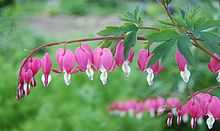Lamprocapnos
| Lamprocapnos | |
|---|---|
 | |
| Scientific classification | |
| Kingdom: | Plantae |
| (unranked): | Angiosperms |
| (unranked): | Eudicots |
| Order: | Ranunculales |
| Family: | Papaveraceae |
| Subfamily: | Fumarioideae |
| Tribe: | Fumarieae |
| Subtribe: | Corydalinae |
| Genus: | Lamprocapnos Endl. |
| Species: | L. spectabilis |
| Binomial name | |
| Lamprocapnos spectabilis (L.) Fukuhara | |
| Synonyms [1] | |
|
Dicentra spectabilis (L.) Lem. | |
Lamprocapnos spectabilis (bleeding heart or Asian bleeding-heart)[2] is a species of flowering plant in the poppy family Papaveraceae, native to Siberia, northern China, Korea and Japan. It is the sole species in the monotypic genus Lamprocapnos, but is still widely referenced under its old name Dicentra spectabilis (now listed as a synonym). It is valued in gardens and in floristry for its heart-shaped pink and white flowers, borne in spring.[3]
Other common names include "Dutchman's breeches", "lyre flower" and "lady-in-a-bath".
Description
Growing to 120 cm (47 in) tall by 45 cm (18 in) wide, L. spectabilis is a rhizomatous herbaceous perennial with 3-lobed compound leaves on fleshy green to pink stems. The arching horizontal racemes of up to 20 pendent flowers are borne in spring and early summer. The outer petals are bright fuchsia-pink, while the inner ones are white. The flowers strikingly resemble the conventional heart shape, with a droplet beneath - hence the common name. The pure white-flowered 'Alba', somewhat more robust than the species, is a popular cultivar.
A Spring ephemeral, the plant frequently dies down to its fibrous roots in summer.[3]
.jpg)
History and legend
First plants specimens were introduced into England in the 1840s from Asia by the Scottish botanist and plant hunter Robert Fortune.[4]
There is also a latest legend from Japan which tells a story of how the bleeding heart flower came to be.[5] In the story, a young man tried win the love of a young lady. He did this by giving a pair of rabbits (which are the first two petals of the flower), a pair of slippers (which are the next two petals of the flower), and finally a pair of earrings (which are the last two petals of the flower) to the girl. She continued to reject his affections, and, heart-broken, he pierced his heart with his sword (the middle part of the flower) which caused the bleeding heart.
Cultivation
In a moist and cool climate, it will grow in full sun, but in warmer and drier climates it requires some shade.
Aphids, slugs and snails sometimes feed on the leaves.
Clumps of dicentra remain compact for many years and do not need dividing. They have brittle roots which are easily damaged when disturbed. Root cuttings should be taken in spring.[6]
Seeds with whitish elaiosomes are borne in long pods. They must be sown while fresh. Division should be done in the late fall (autumn) or early spring.
Cultivars
Several cultivars have been selected. 'Alba' has white flowers, and 'Gold Heart', introduced from Hadspen Garden, England, in 1997,[4] has yellow leaves.
The species[7] and the cultivar 'Alba'[8] have gained the Royal Horticultural Society's Award of Garden Merit.
Toxins
Contact with the plant can cause skin irritation in some people from isoquinoline-like alkaloids.[9][10]
References
- ↑ Germplasm Resources Information Network (GRIN)
- ↑ "BSBI List 2007" (XLS). Botanical Society of Britain and Ireland. Retrieved 2014-10-17.
- ↑ 3.0 3.1 RHS A-Z encyclopedia of garden plants. United Kingdom: Dorling Kindersley. 2008. p. 1136. ISBN 1405332964.
- ↑ 4.0 4.1 University of Vermont: Perry's Perennial Pages
- ↑ "Thursday Myths & Legends 101: Bleeding Heart Flower". Retrieved 12 June 2013.
- ↑ "Bleeding heart". Plant Finder. BBC. 2012. Retrieved 27 April 2012.
- ↑ "Lamprocapnos spectabilis". Royal Horticultural Society. Retrieved 25 July 2013.
- ↑ "Lamprocapnos spectabilis 'Alba'". Royal Horticultural Society. Retrieved 25 July 2013.
- ↑ University of Vermont Department of Plant and Soil Science
- ↑ Leikin, Edited by Jerrold B.; Paloucek, Frank P. (2007), Poisoning and toxicology handbook, Boca Raton, Fla: CRC, p. 886, ISBN 1-4200-4479-6
| Wikimedia Commons has media related to Lamprocapnos. |
| Wikispecies has information related to: Lamprocapnos |